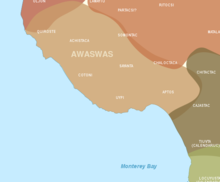 Awaswas territory boundaries with known Indigenous tribes labeled | |
| Total population | |
|---|---|
| c. 600 - 1,400 (1769) | |
| Regions with significant populations | |
| US: CA (Santa Cruz and San Mateo Counties) | |
| Languages | |
| Ohlone language (Awaswas), Spanish, English | |
| Religion | |
| Traditional religion, Animism, Kuksu, Christianity | |
| Related ethnic groups | |
| Mutsun, Ramaytush, Rumsen, Tamien, and other Ohlonean-speaking peoples |
The Awaswas, also known as the Santa Cruz people, were a group of the Indigenous peoples of California in North America, with subgroups historically numbering about 600[1] to 1,400.[2] Academic research suggests that their ancestors had lived within the Santa Cruz Mountains region for approximately 12,000 years. The Awaswas maintained regular trade networks with regional cultures before the Spanish colonists began settling in the area from the 18th century.
The Awaswas people were Ohlone, with linguistic and cultural ties to other Ohlone peoples in the region. "Ohlone" is a modern collective term for the peoples of the region; however, the term was not historically used by the indigenous populations themselves. They did not consider themselves to be a part of a larger tribe, such as the Hopi, Navajo, or Cheyenne, but instead functioned independently of one another.[1]
For centuries, the Santa Cruz Mountains indigenous inhabitants experienced economic competition and military conflict[3] with a series of colonizing newcomers. Centralized government and religious policies designed to foster language shift and cultural assimilation,[3] as well as continued contact with the colonizers through trade, inter-marriage and other intercultural processes, have resulted in varying degrees of language death[4] and loss of original cultural identity.
Awaswas speakers were formerly distributed over much of the northern Monterey Bay area, living along the Pacific Coast and the coastal mountain range of the Santa Cruz Mountains with territories between Point Año Nuevo and the Pajaro River in present-day Santa Cruz and San Mateo Counties.
- ^ a b Robert Cartier. "An Overview of Ohlone Culture: excerpt, originally called "Ethnographic Background", from a 1991 report titled, The Santa's Village Site CA-SCr=239". Santa Cruz Public Library. Archived from the original on 2016-03-04. Retrieved 2023-03-23.
- ^ Cite error: The named reference
wearenotanimalswas invoked but never defined (see the help page). - ^ a b Rizzo-Martinez, Martin (2022). We Are Not Animals: Indigenous Politics of Survival, Rebellion, and Reconstitution in Nineteenth-Century California. Lincoln: University of Nebraska Press. p. 66. ISBN 9781496219626.
- ^ "Awaswas". California Language Archive. University of California, Berkeley. Retrieved 23 March 2023.
© MMXXIII Rich X Search. We shall prevail. All rights reserved. Rich X Search
